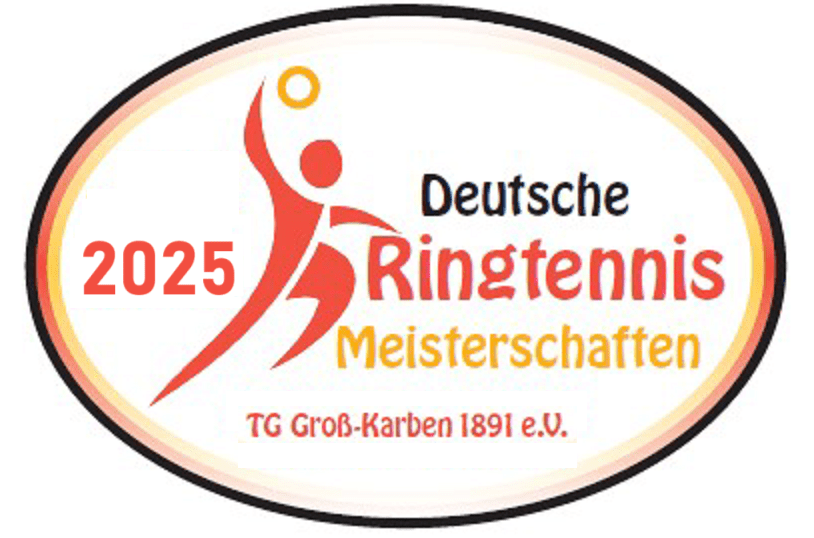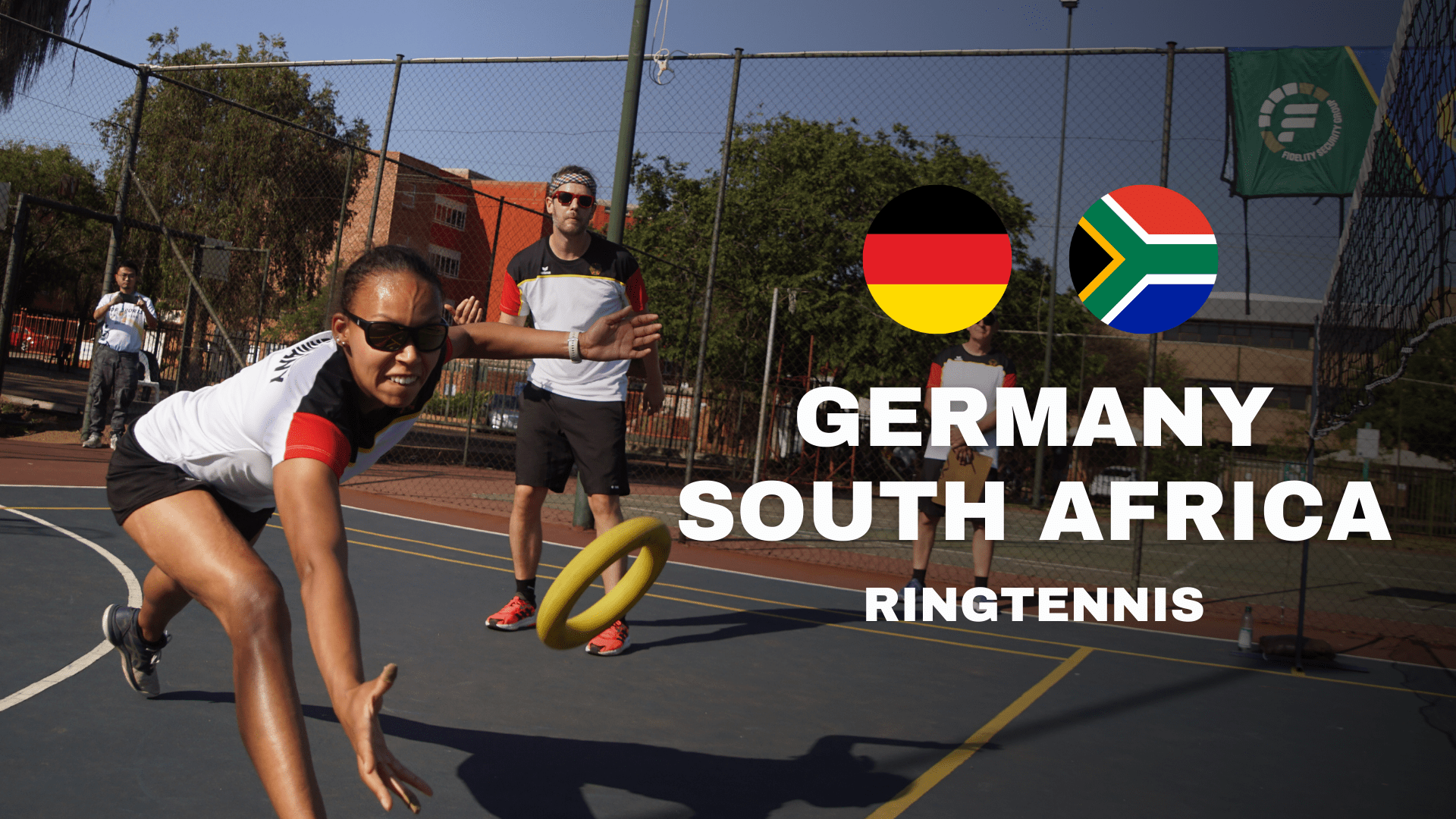The South-African Official Game Rules
S.A. TENNIQUOITS REFFREE’S ASSOCIATION
A. AIMS OF RING TENNIS (TENNIQUOITS)
1. General Aim:
To play a fast and attractive game (also for the spectator) in which is incorporated spectacular movement of the ring and of the player without violating the rules of the game.
2. Specific Aims:
2.1 To put the ring on the floor (ground) inside the opponent’s field of play (untouched or touched by the opponent).
2.2 To keep the ring constantly in movement with out interruptions.
B. MEASUREMENTS & PLAYING EQUIPMENT
1. Playing Court

1.1 The diagram denotes the measurements for doubles (or four player game) as well as singles (or two player game) which shall be 12,2m x 5,5m for the doubles and 12,2m x 4,6m for the singles.
1.2 The neutral area on each side of the net shall be 900mm wide (1,8m in all).
1.3 The neutral area shall extend an additional 1m on each side of the playing area of the court.
1.4 The width of all lines shall be 40mm. All lines form part of the field of play. Measurements must thus be taken from the outer edge of every line.
2. Posts:
2.1 The posts shall be at least 1.6m high and shall be sufficiently firm to keep the net strained.
2.2 The posts shall be at least6m apart.
3. Net:
3.1 The net shall be of tanned or tarred cord or nylon and shall be edged at the top with a white tape,5,5m to 6m in length and 400mm to 500mm deep.
3.2 The net must be 1,6m from the ground at all points and kept strained.
4. Ring:
The ring shall be manufactured of rubber and shall be about 178mm in diameter, 30mm thick and shall weigh approximately 220g to 270g.
C. PLAYING POSITIONS:
1. A game commences as soon as the players and referee are ready.
2. Players may take up any position they wish on the court both at the start and during the course of play (Rule C.3 and C.4 must however be taken into account.)
3. A player may not take up position in the neutral area.
4. Concealed service is not allowed.
D. REFEREES:
1. All official matches must be controlled by a referee.
2. The referee has absolute control of a match. His decisions during a game is final and is at no time subject to objection or dispute. (Explanatory note: Referees also have the power to penalise the conduct of a player which is meant to mislead his opponents by awarding a point against the player or his team. e.g. If a player indicates that a ring is „out“ by calling it as such, but the ring falls in the court, he can be penalised by the referee).
3. Referees shall use a scoreboard or chart during a match.
4. Referees shall keep time of a match only for the duration of a delay (such time shall be added at the end of the game).
5. Undisciplined behaviour: a player shall be cautioned once. If a second warning is necessary, one point shall be subtracted (a negative point). If a third warning is required, the umpire may suspend the player.
E. LINESMEN:
1. Unless both sides agree to play without linesmen officiating, the match official shall appoint two lines men to assist the referee.
2. Linesmen shall only officiate in advisory capacities. (Explanatory note: According to rule D.2 the referee has absolute control of a match. If and when a linesman is requested by the referee to assist him with a particular decision he will for example indicate to the referee whether a player touched a ring, or whether the ring touched the ground and whether a player touched the service – or back line of the court whilst delivering a service).
3. Linesmen will take up their positions behind the service lines on the corners furthest away from the referee.
F. GAME RULES:
1. A match is normally played by either one (known as singles) or two players (known as doubles) on each side.
2. The Game:
2.1 Points are scored by means of a direct count (each fault counts one point.)
2.2 When the time has expired the leading side, e.g. 29-28, 37-17 etc. .shall be the winner. The winner earns two match points.
2.3 The maximum time allocated to a game shall be 24 minutes. Two halves of 12 minutes each shall be played. The players change court ends when 12 minutes have elapsed. The service-in side retains the service. If any delay should occur, such time shall be added at the end of the game.
2.4 If the time has expired:
2.4.1 The leading side e.g. 9-8 shall be the winner, the leading side shall earn two match points.
2.4.2 If the score is a draw, e.g. 17-17, each side shall earn one match point.
2.5 Championship tournaments
Should the score still be a draw at the end of the game, the first side to score after the resumption shall be declared to be the winning side. (The choice of court ends or first service shall be decided by toss before play commences.) (For further description of championship tournaments including exceptions in this regard, please refer to the domestic bye-laws of the Board.
3. The league match
3.1 The team:
A team shall consist of four men players and four women players.
3.2 Singles, mixed doubles, men’s double and women’s doubles shall be played. In this regard please refer to the domestic bye-laws of the Board.
4. The Service:
4.1 The choice of court ends or first service shall be decided by toss, the winners of the toss having choice of a specific court end. The losers take the first serve (becoming the service-in side).
4.2 In doubles any player of the service-in side may take the service and he may deliver it on any one of his two opponents. (Take in account rule C.4.)
4.3 The service may be received by any one of the players of the service-out side.
4.4 The player or team who become the service-in side on the toss retains the service until they commit a fault (i.e. until their opponents score a point); in which case the service is then transferred to the original service-out side. (Explanatory note: The service thus changes every time the service-in side commits a fault).
4.4.1 In calling the score the umpire must always call the points of the service-in side first.
4.5 The ring must leave the hand of the server before his feet touch either the service-line or the playground.
4.6 The ring may not touch the net during the service or during general play.
5. Handling the ring:
5.1 The ring may be caught with the hand only. In the event of the ring being pressed against any part of the body (the sole exception being the arm below the elbow of the hand catching the ring) it is considered to be a fault.
5.2 A player may not touch the ring with both hands simultaneously.
5.3 If the ring should fall from the hand of a player whilst he is striving to catch it, it may be caught.
i) by the same player again (subject to rule 5.5).
ii) by his partner
iii) by both players simultaneously (also refer to rule 5.5) Provided that the ring is not handled more than twice by the team.
5.4 The ring must be returned by die same hand with which it is caught.
5.5 In a doubles match it is permissible for one hand of each partner to catch the ring at the same time but only one player may return it. The ring must be thrown high to the rear third section of the court. (Hesitation in returning a ring under these circumstances is a fault under rule 7.5)
5.6 The ring may not be hit or slapped over the net.
5.7 A short throw bouncing back from the net or net posts to the throwers may not be caught and thrown a second time.
5.8 The hand of the Player handling the ring may not be brought over the net.
6. In Play:
6.1 A ring thrown against the net, or touching the net in passing over, counts against the side delivering the ring irrespective of whether their opponents catch or touch the ring.
6.2 A ring falling untouched (and being otherwise faultless) in the neutral area or out of bounds, counts against the side delivering the ring.
6.3 A ring falling untouched and otherwise being faultless, „in bounds“ counts against the side failing to catch it.
6.4 A ring touched by the receivers and then falling within the neutral area or otherwise inside or outside the court boundaries counts against the side failing to catch it properly.
6.5 A player may catch the ring no matter where he is standing. (Refer, however to rule 6.13 to the neutral area).
6.6 The first point of contact with the ground is deemed to be the place where the ring has touched, irrespective of where it eventually comes to rest.
6.7 A ring touching a boundary line (inclusive of the 5.5m line marking the boundary between the court and the neutral area) is deemed to be ?in bounds“.
6.8 A ring may not touch the ground during play, irrespective of whether it was caught before touching the ground.
6.9 The ring must be played over the net between the posts and may not pass beyond the posts.
6.9.1 The ring may not touch the posts in play or when being served.
6.10 A player may return the ring whilst his back is turned to his opponents.
6.11 If a player catches the ring with his back turned to the net he is allowed to correct his position before returning the ring (subject to the provise that rule 7.5 is not breached) and then it must be thrown to the rear third section of the court.
6.12 Both in serving and in play the delivery of the ring must be made at the same height at which the hand is and the forward movement of the ring must be on the same horizontal plane or it must have a rising trend, otherwise it is a fault. (Explanatory note:
i) A flat ring – a ring released at the same horizontal level at which the hand is. The distance this ring moves forward, after it is released by the hand, should be observed by one?s eye before it loses vertical height.
ii) A down ring – a ring delivered directly downwards from the hand. It is a fault.
iii) A rising ring – a ring which, after it has been released does not necessarily move in a forward direction but moves upwards and this vertical distance should be observed by one’s eye before it starts to descend.)
6.13 A player may touch the neutral area boundary line but may not tread in the neutral area or the extension thereof.
6.14 No person not participating in the match may be allowed on the court during play or whilst the players are changing ends before the commencement of the next game except the team manager.
6.14.1 In case of injuries only those persons rendering first aid to the injured player are allowed on the court and also the team manager.
6.14.2 Spectators are not allowed between the playing courts during games.
6.15 A player may not leave the court during a match without the permission of the referee.
6.15.1 Use of refreshments: water and other refreshments may only be used between games and not during a game, except where the referee permits otherwise.
7. Inadmissible Play:
Besides items already mentioned in rules 1-6 the following is considered to be inadmissible play.
7.1 Deliberate delaying, baulking or interruption of play. (Explanatory note: This rule refers to a player who deliberately delays play as such e.g. a player feigns sickness or injury.)
7.2 Feinting with the ring. (Explanatory note:
i) A distinctions must be made between a „two direction movement“ of a player’s arm, „numerous“ (i.e. to and from) movements of his wrist, both which qualify as a „feint“ and the „single“ wrist action used in spinning a ring.
ii) A player may move his body to and from providing that the ring is kept moving and that his body movement does not induce a feint with the throwing arm or wrist.)
7.3 Improvement of playing position: If the player, after catching the ring, gains an impermissible advantage by running, jumping or walking several steps with the ring, i.e. when taking more than one step (the lunge stop is excluded). (Explanatory note: The permissible action is as follows:
i) Catching the ring – while jumping (into the air) towards the net – with a forward momentum.
ii) First position on the ground and holding the ring.
iii) Taking one step:
iv) The lunge step
v) The ring must leave the hand before the foot with which the lunge step is taken touches the ground.
vi) This one-stop-lunge-step movement is a fast smooth forward action and not slow or intermittent.
vii) A player may not catch the ring in a stationary position and then start moving in a forward motion.)
7.4 Wobblers:
(Explanatory note: A wobbler is a ring which wobbles excessively or overturns. Excessively move from side to side more than the diameter of the ring, i.e. 30mm)
7.5 Hesitation:
Deliberate retarding or hesitation to return the ring immediately after catching it. (Explanatory note:
i) A short hesitation: e.g. catching the ring near the net after a short attacking throw – the ring is stopped for a moment and then returned (a moment is 1 second or a counting of thousand-and-one.)
ii) A long hesitation: When catching the ring a player is temporarily off balance. He is allowed to regain balance and he must return the ring as quickly as possible (quickly as possible is 2 to 4 seconds or 1 count of thousand-and-one to thousand-and-four.)
iii) In case of hesitation (ii) the ring must be thrown high to the rear third part of the opponent’s playing field otherwise it is a fault.
iv) If a player dives in order to catch a ring he is permitted to correct his playing position and return the ring immediately otherwise it is a fault.
v) To be able and in a position to attach near the net the ring must be handled with a smooth catch-and-throw action, or a short hesitation. Otherwise it is a fault.
vi) When play is interrupted by the referee (for any reason – except when points have been scored) the ring must be played high twice. The referee shall indicate so very clearly.
vii) A hesitation of more than 4 seconds is a fault and punishable under rule 7.1 namely deliberate delaying.)
VANDERBIJLPARK – 24 June 1983


